I moved to Los Angeles two years ago and learned right away that I was unprepared for West Coast life. Before even buying my plane ticket I should have listened to the old Beach Boys song and cultivated a bushy, bushy blonde hairdo. I thought it was just a surfer thing, but everyone here has one: the mayor, the specialist who came to install the “edible wall garden” on my composting shed, the police officer who ticketed me for my backyard pizza oven (I burn lawn clippings in there), everyone! The other biggie: My diet of grains, meats, vegetables, and homemade fruit leather was far too varied. Apparently all I ever need to eat for the rest of my life is kale. And I swear to you on the tub of Sun-In hair lightener into which I dunk my increasingly bushy head each morning: I will achieve a kale-only diet.
In case you’re not aware, kale—a bitter, cabbage-like vegetable often seen being swallowed by Gwyneth Paltrow—is now the only food worth the trouble of digesting. Kale sautéed with red wine vinegar and garlic. Kale salad, soaked in fresh lemon juice with toasted kale shavings and a side of kale. Where I grew up, “loaded nachos” referred to tortilla chips heaped with chili, cheese, sour cream, olives, and guacamole. In most parts of Los Angeles it means kale.
Kale has something for everybody. The elderly eat kale to prevent age-related macular degeneration, and because the guy stocking it in the produce department seemed like a very nice young man. Health conscious parents empty out their kids’ Cheetos bags and fill them with sea-salt-dusted kale chips, then tell their kids the old kind of Cheetos were just a dream. Elite athletes like Alex Rodriguez and Troy Polamalu incorporate nutrition-rich kale into their training diets, and Jose Canseco allegedly puts kale directly into his ass after working out.
And that’s just the beginning. Hospital patients designated as “nothing by mouth” accept intravenous kale juices (again, with garlic and a splash of red wine vinegar). Cats and dogs eat kale and hate it unless it’s given to them in a block of cheese or a hot dog, but what are Californians gonna do, not feed their pets kale?
Why is kale so beloved, not just in Los Angeles but in any city currently hosting a restaurant run by a former Top Chef contestant? Because it’s a superfood. Researchers have identified 45—count ‘em—different flavonoids in kale, and as something of a “flavonoid queen” I take that as exciting news indeed. Kale is also high in fiber, packed with antioxidants, and rich in vitamins—particularly vitamin K, which I’m not familiar with but believe is a potent designer party drug. And of course, kale prevents cancer, and does so much more effectively than that case of açai berry juice I now use as a laundry-folding station, or the pomegranate tree I planted but now might chop down to restore my view of my neighbor’s bathroom window (a subject for a different essay).
After months of pestering from friends, family, waiters, Food Network hosts, and Gwyneths, I consulted my personal physician about whether it was time to switch to a strict, all-kale diet. Yes, she said, it was time, though she warned me that cutting out nonkale foods would make me anemic and that I’d eventually start peeing a substance much like the cabbage stew once served in Victorian workhouses. Small price to pay! She asked me to keep a kale journal.
* * *
DAY 1: I began the process of purging my system of all nonkale contaminants. I also purged my refrigerator of the many bushels of purple kale I’d bought over the preceding months and left to rot in my crisper drawer. That was the old me. The new me was going to eat this wrinkly, unappetizing weed and he was going to like it.
DAY 2: Many foods give up their charms all too easily. Not so of kale. In order to coax from it even the most basic edibility, kale must actually be massaged. Massaging breaks down the tough kale leaves and tempers their off-putting taste and texture (i.e. their “kaleness”). Most chefs massage their kale for 5 to 10 minutes in a mixing bowl. I went longer than that for my first kale salad—an hour and a half total—mostly because that’s what I’d want if the kale were massaging me.
DAY 3: It was already getting easier. Fellow shoppers at the farmers market were sneering at me less, and I felt less temptation to murder people who tweeted things like this.
DAY 4: Kale for breakfast, lunch, and dinner. I snacked on kale, used prison hunger strike countermeasures to force-feed kale to my cat, and chewed only kale-flavored Orbit gum (tough to track down; L.A. might be a test market). Dr. Oz stopped by to place a garland of kale atop my head and even let me try on his scrubs. A truly great day.
DAY 5: Turbulence. I had a nightmare about kale and woke to see I’d soaked my sheets with green sweat. My cat left me.
DAY 6: I broke down and ate entire chafing dishes of fried okra and sausage links at the Sizzler buffet. But after that I got right back on the wagon!
* * *
So there you have it: my diet isn’t an easy one to maintain. I cheat every so often, and then I’ll sometimes do things like buy $100 worth of kale, stomp it into the ground, and marinate it in my salty tears of rage. But these outbursts are rare. And you know what’s good for calming them? A nice kale massage.
